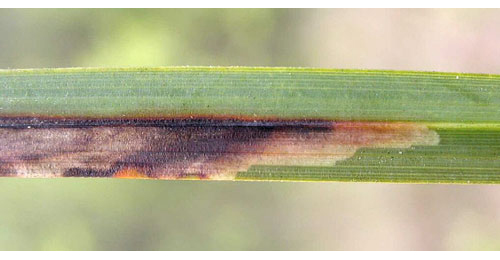|
||||||
|
Elachista
gleichenella (Fabricius, 1781) Twin-barred Dwarf Tinea
gleichenella
Fabricius,
1781 |
|||||||||||||||||||||||||||||||||||||||||||||||||||||||
|
Leaf-miner: The larva starts mining near a leaf tip in early autumn. This early mine approximates to being linear but is very erratic in its course. In earl winter the the larva usually moves to anew leaf. This second mine usually takes the form of a compact but irregularly brownish blotch close to or often within the area of purplish discoloration of the dying leaf tip. Occasionally the larva does not change mines but extends the one made in autumn. Pupation takes place in a concealed place amongst debris or between closely applied leaves (Bland and Knill-Jones, 1988). Egg generally at the underside of the leaf tip. From September till the following spring a narrow meandering corridor is made. Then gradually the corridor widens to nearly the full width of the leaf. Generally the larvae make a new mine in early winter, obviously without the initial corridor. The mine in this stage is brown and situated close to (or within) the red coloured dying apical part of the leaf. Frass in large elongate dark spots. Pupation external (Bladmineerders van Europa).
Larva: The larvae of moths have a head capsule and chewing mouthparts with opposable mandibles (see video of a gracillarid larva feeding), six thoracic legs and abdominal legs (see examples). The larva has brownish head, black prothoracic plates and a greyish white body with a greenish tinge (Bland and Knill-Jones, 1988). The full grown larva is greyish green, with a dark brown head and a black prothoracic plate. Characteristic details of the prothoracic plate are discussed by Steuer (1980a). The larva is illustrated in Bladmineerders van Europa. Pupa: The pupae of moths have visible head appendages, wings and legs which lie in sheaths (see examples). Described by Patocka (1999a), Patocka and Turcáni (2005a) (Bladmineerders van Europa). Adult: The adult is illustrated in UKMoths. The species is included in mothdissection.co.uk. Hosts in Great Britain and Ireland:
Hosts elsewhere: Time of year - larvae: September - May the following year (Bladmineerders van Europa). Time of year - adults: Currently unknown. Distribution in Great Britain and Ireland: Britain including Banffshire, Bedfordshire, Caernarvonshire, Carmarthenshire, Denbighshire, Derbyshire, Dorset, Durham, East Gloucestershire, East Norfolk, East Suffolk, Flintshire, Glamorgan, Haddington, Herefordshire, Hertfordshire, Isle of Wight, Kincardineshire, Leicestershire, Merionethshire, Monmouthshire, North Hampshire, North Somerset, Shropshire, South Aberdeenshire, South Wiltshire, Stafford, Stirlingshire, West Gloucestershire, West Kent, West Lancashire, West Norfolk, Westmorland and Worcestershire (NBN Atlas). Also recorded in the Republic of Ireland and Northern Ireland (Fauna Europaea) See also Ireland's National Biodiversity Data Centre Map). Distribution elsewhere: Widespread in continental Europe including Austria, Belgium, Czech Republic, Danish mainland, Estonia, Finland, French mainland, Germany, Greek mainland, Hungary, Italian mainland, Latvia, Lithuania, Norwegian mainland, Poland, Russia - North, Slovakia, Sweden, Switzerland and Ukraine (Fauna Europaea). NBN Atlas links to known host species: British and Irish Parasitoids in Britain and elsewhere:
|
|
|
|
| External links: | Search the internet: |
Belgian Lepidoptera |
Find
using Google Find using Google Scholar Find images using Google |
| Last updated 17-Oct-2019 Brian Pitkin | ||

